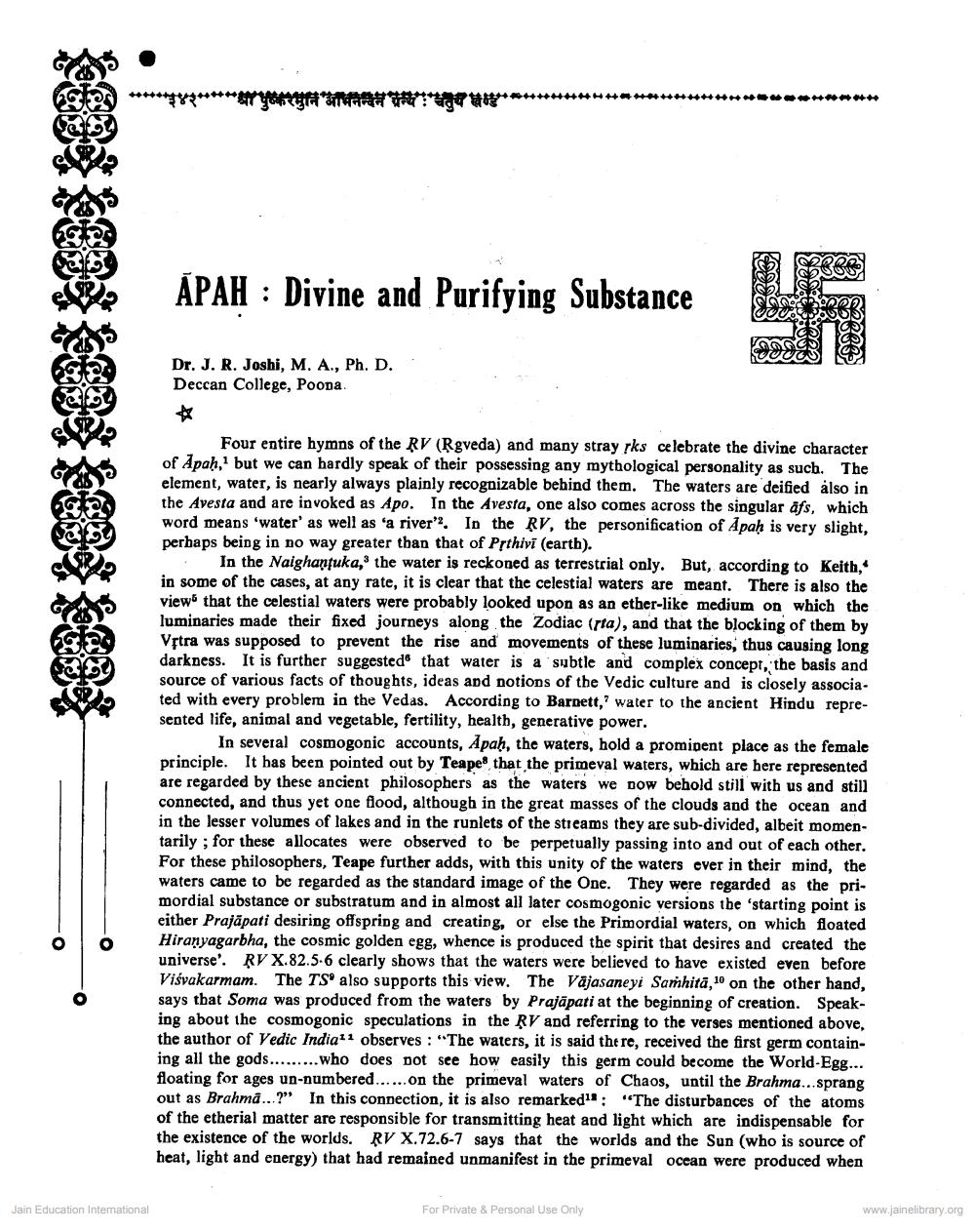________________
*********
*****************************
****
ÁPAH : Divine and Purifying Substance
Dr. J. R. Joshi, M. A., Ph. D. Deccan College, Poona.
Four entire hymns of the RV (Rgveda) and many stray ;ks celebrate the divine character of Apah, but we can hardly speak of their possessing any mythological personality as such. The element, water, is nearly always plainly recognizable behind them. The waters are deified also in the Avesta and are invoked as Apo. In the Avesta, one also comes across the singular afs, which word means 'water' as well as 'a river'?. In the RV, the personification of Apaḥ is very slight, perbaps being in no way greater than that of Prthivi (earth).
. In the Naighantuka, the water is reckoned as terrestrial only. But, according to Keith, in some of the cases, at any rate, it is clear that the celestial waters are meant. There is also the view that the celestial waters were probably looked upon as an ether-like medium on which the luminaries made their fixed journeys along the Zodiac (rta), and that the blocking of them by Vstra was supposed to prevent the rise and movements of these luminaries, thus causing long darkness. It is further suggested that water is a subtle and complex concept, the basis and source of various facts of thoughts, ideas and notions of the Vedic culture and is closely associated with every problem in the Vedas. According to Barnett,' water to the ancient Hindu represented life, animal and vegetable, fertility, health, generative power.
In several cosmogonic accounts, Apah, the waters, hold a promipent place as the female principle. It has been pointed out by Teape that the primeval waters, which are here represented are regarded by these ancient philosophers as the waters we now behold still with us and still connected, and thus yet one flood, although in the great masses of the clouds and the ocean and in the lesser volumes of lakes and in the runlets of the streams they are sub-divided, albeit momentarily; for these allocates were observed to be perpetually passing into and out of each other. For these philosophers, Teape further adds, with this unity of the waters ever in their mind, the waters came to be regarded as the standard image of the One. They were regarded as the primordial substance or substratum and in almost all later cosmogonic versions the 'starting point is either Prajapati desiring offspring and creating, or else the Primordial waters, on which floated Hiranyagarbha, the cosmic golden egg, whence is produced the spirit that desires and created the universe'. RV X.82.5-6 clearly shows that the waters were believed to have existed even before Viśvakarmam. The TS also supports this view. The Vajasaneyi Samhita, 10 on the other hand, says that Soma was produced from the waters by Prajāpati at the beginning of creation. Speaking about the cosmogonic speculations in the RV and referring to the verses mentioned above, the author of Vedic India 11 observes : "The waters, it is said the re, received the first germ containing all the gods...... ...who does not see how easily this germ could become the World-Egg... floating for ages un-numbered...... on the primeval waters of Chaos, until the Brahma...sprang out as Brahma...?" In this connection, it is also remarked!! : "The disturbances of the atoms of the etherial matter are responsible for transmitting heat and light which are indispensable for the existence of the worlds. RV X.72.6-7 says that the worlds and the Sun (who is source of heat, light and energy) that had remained unmanifest in the primeval ocean were produced when
Jain Education International
For Private & Personal Use Only
www.jainelibrary.org




